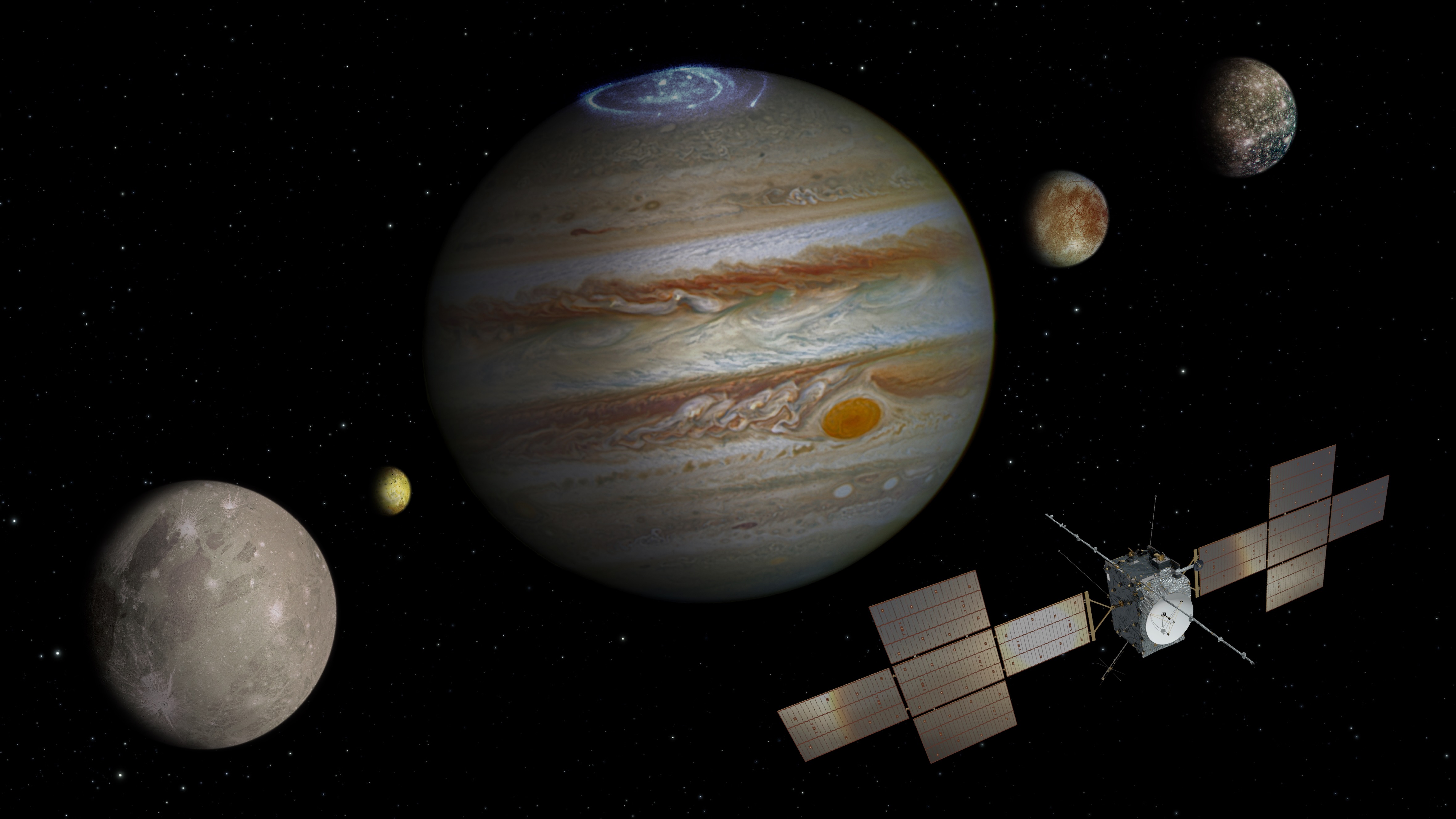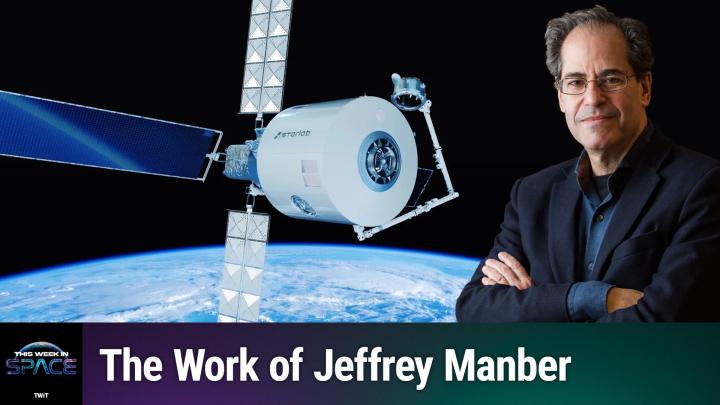How the risk of biological contamination could complicate the fate of Europe's Jupiter mission
If Ganymede is potentially more habitable than previously thought, scientists will have to think carefully about where to crash JUICE on the Jovian moon.

The fate of the European Space agency's JUICE mission could be complicated should it be discovered that biological material brought on the spacecraft from Earth could reach Ganymede's underground ocean more easily than previously thought.
When it launches in April 2023, JUICE (short for "Jupiter Icy moons Explorer") will set course for what could be the best chances to find alien life in the solar system. JUICE's primary targets — the Jupiter moons Europa, Ganymede and Callisto — are all thought to contain subterranean oceans beneath a thick crust of surface ice, and it is possible that conditions for life could exist within these oceans.
This means that special rules must be adhered to on the mission to minimize any possibility of contaminating those moons with Earthly biological material that could interfere with future searches for life. These rules are referred to collectively as "planetary protection," and COSPAR (the international Committee on Space Research) has outlined five categories of planetary mission depending upon the degree of planetary protection required. Category I is a mission to a lifeless body like Mercury. Category II missions are flyby or orbiter missions that venture to worlds where there may be some possibility of life, but the chances of contamination are slim. Then there's category III, where the chances of contamination are deemed greater. Category IV refers to landers on potentially habitable bodies, and category V is sample-return back to Earth.
Related: The big Galilean moons of Jupiter (photos)
Europa has been identified as a category III object, whereas Ganymede is currently only category II.
"The planetary protection classification for Ganymede is driven by the likelihood that living organisms from Earth, brought to Ganymede by the spacecraft, can make their way down to the ice-ocean interface," said Claire Vallat, who is the JUICE science operations scientist at the European Space Agency, in an interview with Space.com.
JUICE's main constraint from the planetary protection side of things is avoiding any risk of crashing on neighboring Europa, which is thought to have a thinner ice shell and therefore easier access to the underlying ocean. "In turn, this likelihood is deemed so low for Ganymede that it justifies a category II protection level, allowing for the spacecraft to be disposed on Ganymede's surface," said Vallat.
Breaking space news, the latest updates on rocket launches, skywatching events and more!
The plan at the end of JUICE's mission is therefore to crash the spacecraft into Ganymede. However, this plan will be complicated if JUICE actually finds exciting news at Ganymede.
Ganymede isn't just Jupiter's largest moon, it's the largest moon in the entire solar system with a diameter of 3,272 miles (5,268 kilometers) — greater even than the planet Mercury. Ganymede is also the only moon that has its own intrinsic magnetic field, generated by a dynamo deep in its core. However, evidence for a salty ocean underneath Ganymede comes in the form of a secondary magnetic induced in it by Jupiter’s powerful magnetosphere. This affects the amount by which Ganymede’s aurora (another unique property of this moon) appear to rock back and forth in their interactions with Jupiter’s magnetosphere.
Ganymede's ocean may contain more water than all of Earth's seas, but it's buried beneath an icy crust estimated to be 90 miles (150 km) thick. Europa's icy crust, by contrast, is thought to extend only 9 to 15 miles (15 to 24 km) deep, allowing the sharing of material between its ocean and the surface. The presence of sea salts on the surface and the detection of apparent water plumes also suggest that Europa's ocean may have some connection with its surface.
However, estimates of the thickness of Ganymede's crust are based on theoretical modeling — it hasn't actually been directly measured yet.
Related: The search for alien life (reference)
When JUICE arrives in the Jovian system in 2031, it will perform a couple of flybys of Europa, 21 flybys of fellow icy moon Callisto, and 12 close passes of Ganymede before settling into orbit around Ganymede in 2034. From this vantage point, "JUICE will be able to constrain the thickness of the crust, because we will have very good coverage of the entirety of Ganymede," said Vallat.
Should there be a surprise — for example, perhaps JUICE will discover thinner parts of the crust, or some mechanism that is transporting material, perhaps convectively, between the ocean and the surface — then Ganymede’s planetary protection category could change.
JUICE would still have to crash into Ganymede's surface – once it is in orbit around Ganymede there will be no way to avoid that – but a way of safely disposing of the spacecraft would need to be found, without posing a contamination threat to Ganymede’s ocean, now or at any time in the future.
"If Ganymede's category is changed to category III by COSPAR, then we will have to investigate if and how this may affect the disposal of the spacecraft," says Vallat.
One solution, following discussions with the astrobiology and planetary science communities, might be that JUICE will be able to crash in an older highland region where the ice shell is thicker, minimizing the risk.
Should Ganymede's planetary protection category be changed, it would not be an unwelcome headache for the JUICE team, since part of the mission's remit is to probe the potential habitability of Jupiter's icy moons and better understand the conditions that could render them habitable.
"It would be fantastic from a science point of view," says Vallat.
While JUICE will not be able to observe the oceans directly, it will be able to characterize them indirectly. For example, its laser altimeter and radio science experiment will measure the tidal response of Ganymede to Jupiter's gravitational pull to characterize Ganymede’s interior.
"JUICE is the next step in understanding habitability in icy moons around gas giants," concluded Vallat. "It will help answer so many questions that are important for humankind."
Editor's note: This article was updated on March 9 to include clarifications from JUICE team members.
Follow Keith Cooper on Twitter @21stCenturySETI. Follow us on Twitter @Spacedotcom and on Facebook.

Keith Cooper is a freelance science journalist and editor in the United Kingdom, and has a degree in physics and astrophysics from the University of Manchester. He's the author of "The Contact Paradox: Challenging Our Assumptions in the Search for Extraterrestrial Intelligence" (Bloomsbury Sigma, 2020) and has written articles on astronomy, space, physics and astrobiology for a multitude of magazines and websites.
